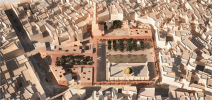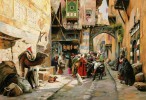Read the text carefully and answer the following questions
The city in Islam is an essential element of civilization the building cities, improving them, and providing services was seen as religious actions, these cities didn't have public open spaces, and all the open spaces were protected within courtyards.
Muslims started the urbanization process quickly after entering the new lands, this urbanization took place in two types of cities:
• The inherited cities: These are cities which were built before Islam, and the Muslims occupied them and started altering them, examples: Damascus, Alexandria, Samarkand.
• The designed cities: These are the cities which were built completely by the Muslims, with a primitive or a complex masterplan., examples: Kufa, Baghdad, Cairo.
The designed cities were also of a few types: they were either defending cities, administration capitals or religious centers.
Civilization in Islam is connected to the city, and a city is not a city without the congregation El-masjid ,this is why El-masjid was the first element of any city planning.
In all the cities, the first step was to decide the location, this was done after a long study of the environmental and geographical characteristics of the region, after deciding the location, the site of the masjid was chosen, and the building was planned, then main streets were laid parallel and perpendicular to the masjid's walls, defining a grid.
The city was then divided among the people each part was called (khitta), finally a protection wall was built around it, this was the case for all the cities except the administrative capitals.
A typical Islamic city would have a masjid in the center, surrounded by the market place and then the residential areas. Public buildings were on the main arteries.
1. El-masjid
El-masjid is usually hidden within the center, for this raeson, masjid is not the place of praying in congregation only ,moreover at the masjid teaches people unity, also it serves as a meeting place where people discuss their problems and try to find solutions for them.
2. The Markets
The markets represent the commercial heart of the city, Some cities had the shops and khans located on the main arteries of the city surrounding its center, which is usually the masjId. Other large cities developed a specific layout for a covered marketplace, Markets and shops were usually arranged according to specialty, they were controlled with gates which were closed at night. And at day time ,government officials would control the commercial activities.
3. The House
The house is the building block of the Islamic city, the nature of the house represents the nature of the Muslim family The Muslim house is enclosed and inward-oriented, and has all the activities inside the house in the very protected environment. In the Islamic culture women are not supposed to be exposed to strangers and the high level of privacy needed for the Muslim family was supported well by the building typology. The house, and its internal courtyard also works in unison with the alleys and streets, and all work together as an ecological system. Usually each neighborhood had a clear entrance and sometimes a gate.
4. The Streets
Streets are of different types depending on the functionality. The urban pattern is organic and irregular, generally the walls are high and the street section is narrow. There is a very small amount of detailing on the exterior walls, which gives the feeling of walking in a trench. The Streets Direction changes a lot while moving and the views are interrupted with sudden angles and closed vistas. Narrow streets give a sense of protection. And the narrow organic planning is useful environmentally by keeping the streets cold and far from sunshine as much as possible.
Adapted from
No'man BayatyThe Islamic City -Islamic Architecture

